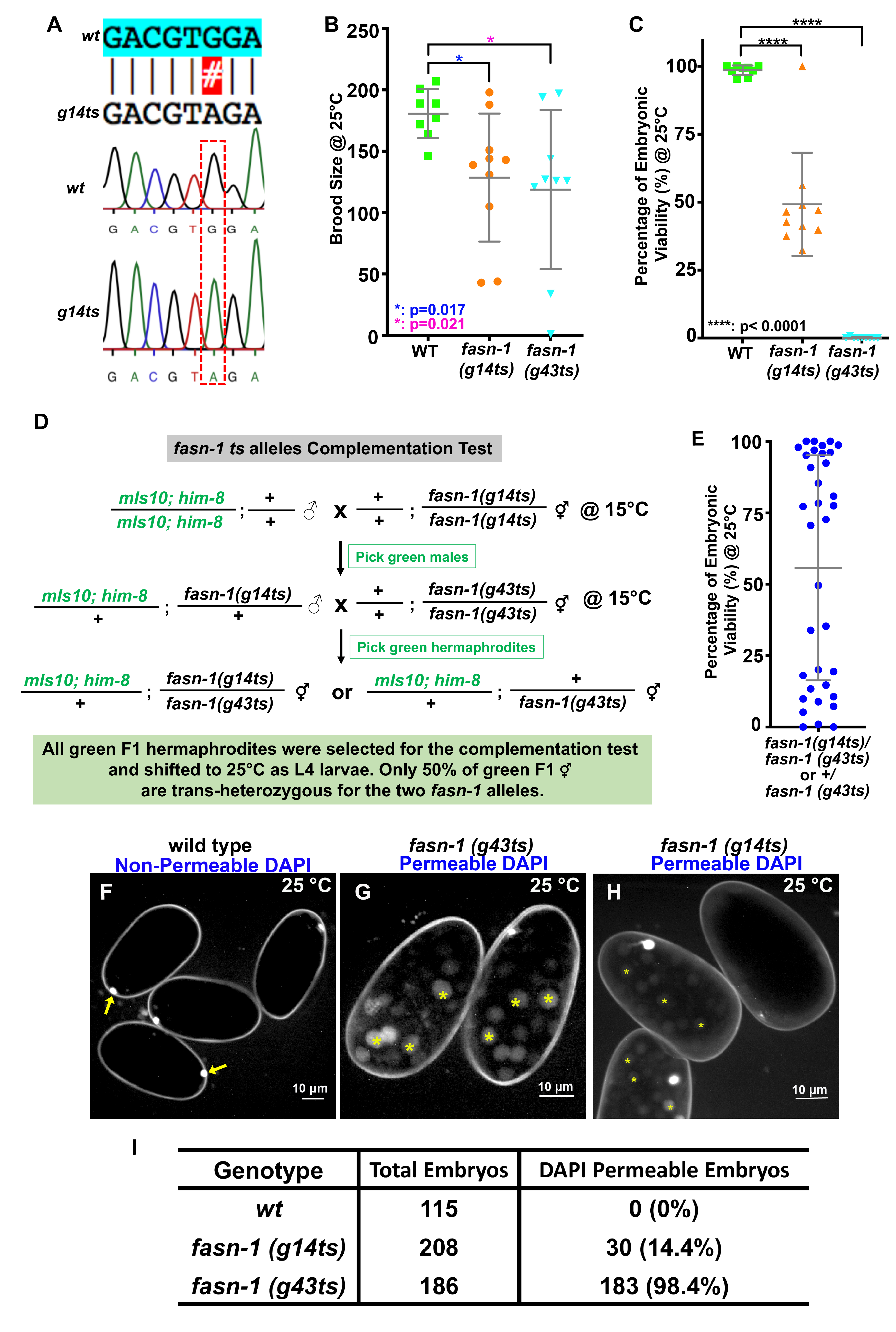Description
We had previously identified the causative mutation in emb-14(g43ts) as an Ala1425Thr missense mutation in the C. elegans fasn-1 gene on LGI (Jaramillo-Lambert et al. 2015). At that time, it was suggested that the emb-14 gene be renamed fasn-1. FASN-1 is a fatty acid synthase orthologous to human FASN (Lee et al. 2010). The g43ts allele is a tight, highly penetrant temperature-sensitive allele. There are presumably two other alleles, g14ts and fr8. We characterized the osmotic sensitivity of g14ts embryos, as well as the brood size and embryonic viability of the g14ts allele. We also demonstrated that g14ts failed to complement the tight temperature-sensitive allele, g43ts. We also determined the sequence alteration of g14ts to be a Gly1830Arg missense mutation upon sequencing PCR fragments that covered the entire fasn-1 gene (Fig. 1A). fr8 was previously identified as an M241I missense mutation in the fasn-1 gene. Interestingly, 40% of fasn-1(fr8) embryos fail to hatch (Lee et al. 2010).
The brood size of the g14ts and g43ts strains were variable but statistically different than N2, the wildtype strain (Fig. 1B). Brood size was determined by moving mothers each day to fresh plates and counting the number of hatched larvae and unhatched dead embryos on each plate 24 hrs after moving the mothers. Daily transfers were performed until the mothers stopped laying fertilized embryos. Brood size was defined as the sum of hatched larvae and unhatched dead embryos. Embryonic viability (% hatching) at 25°C was quite variable for g14ts (Fig 1C). However, g43ts embryos failed to hatch at 25°C, while the wildtype embryos hatched >98% (Fig. 1C).
To confirm that g14ts was an allele of fasn-1, we did a complementation assay with g43ts (Fig. 1D). We used males marked with a pharyngeal GFP marker (mIs10) to confirm that cross progeny were being analyzed. Half of the F1 hermaphrodites should be g14ts/g43ts while half should be just g43ts/+. All F1 animals were then shifted to 25°C as L4 larvae, and the embryonic viability of each mother was quantified (Fig. 1E). Embryonic viability was bimodal, likely reflecting that half the F1 failed to complement at 25°C, and the other half were g43ts/+ mothers with high levels of embryonic hatching.
To quantify the defective eggshells of the fasn-1 mutants, N2, g14ts, and g43ts were subjected to DAPI staining. Young gravid hermaphrodites were washed in M9 buffer three times and dissected with 23 G x 3/4” needles. Different stage mitotic embryos were transferred to a homemade hanging drop chamber made by molten Vaseline (Edgar and Goldstein 2010). The chamber was filled with Blastomere Culture Medium (BCM) with 5 μg/ml DAPI. The images were captured by high-resolution confocal microscopy with a Nikon 60 X 1.2 NA water objective with 1 μm z-step size. Images were generated by custom Fiji Image J>Stacks>Z project (Linkert et al. 2010, Schindelin et al. 2012). As expected, N2 embryos were not permeable to DAPI (other than the first polar body; Fig. 1F) while fasn-1(g43ts) embryos were highly permeable. fasn-1(g14ts) embryos were variably osmotically sensitive with only 14.4% showing DAPI permeability (Fig. 1G, H). fr8 was also reported to be permeable to the lipophilic dye Nile red (Lee et al. 2010). Of the three existing alleles, g43ts is the tightest and most penetrant. Suppressor screens with this allele would be quite straight forward.
Reagents
N2: Bristol (wild type)
GG14: fasn-1(g14ts) I
GG43: fasn-1(g43ts) I
TY4236: him-8(e1489) IV; mIs10 V.
All strains are available from the CGC.
Acknowledgments
We thank the Caenorhabditis Genetics Center, which is funded by National Institutes of Health Office of Research Infrastructure Programs (P40OD010440), for providing strains for this study.
References
Funding
This work was supported by the Intramural Research Program of the National Institutes of Health, National Institute of Diabetes and Digestive and Kidney Diseases
Reviewed By
AnonymousHistory
Received: April 11, 2020Revision received: May 4, 2020
Accepted: May 4, 2020
Published: May 5, 2020
Copyright
© 2020 by the authors. This is an open-access article distributed under the terms of the Creative Commons Attribution 4.0 International (CC BY 4.0) License, which permits unrestricted use, distribution, and reproduction in any medium, provided the original author and source are credited.Citation
Bai, X; Woodbury, D; Golden, A (2020). The fasn-1(g14ts) allele is a Gly1830Arg missense mutation in C. elegans FASN-1. microPublication Biology. 10.17912/micropub.biology.000244.Download: RIS BibTeX




